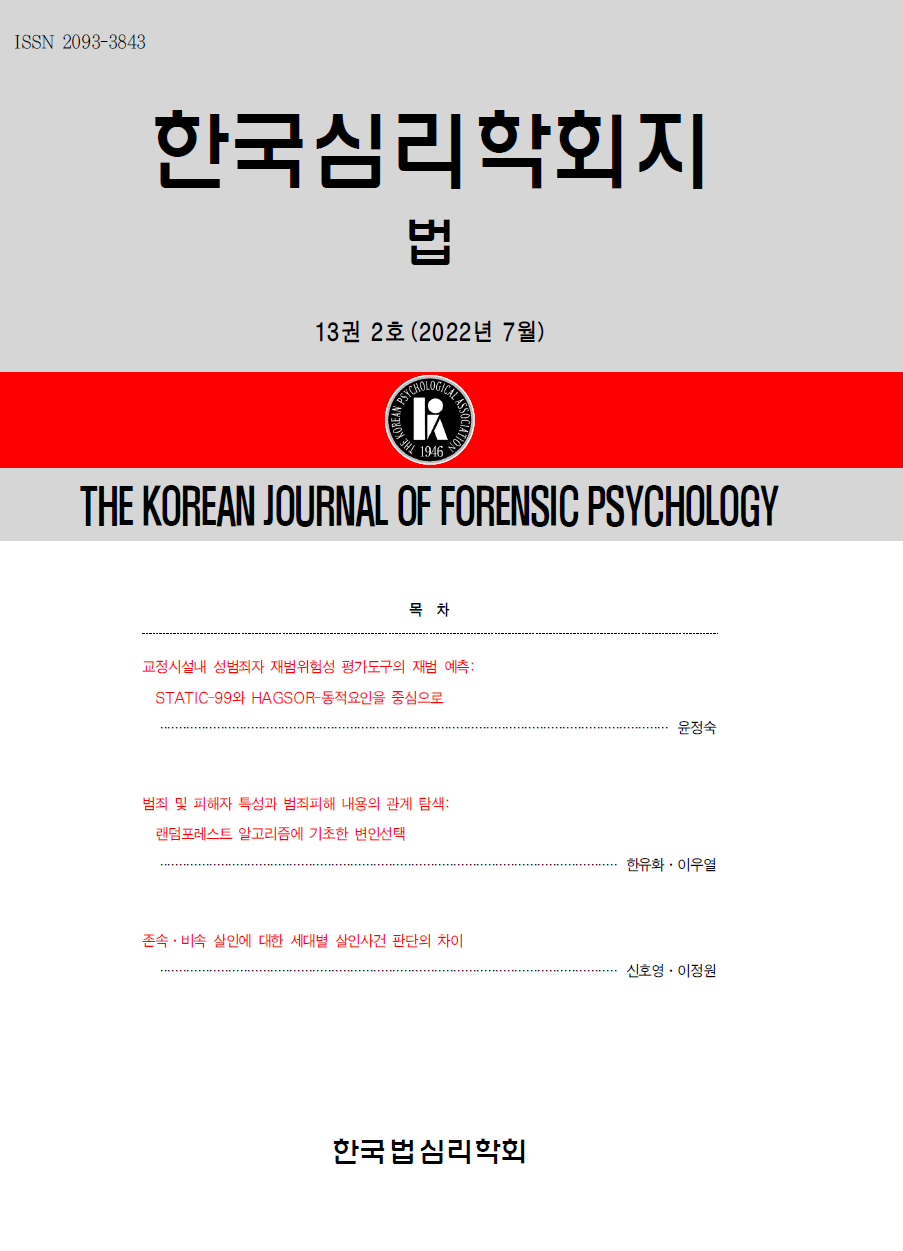 ISSN : 2093-3843
ISSN : 2093-3843
The current study aimed to test the impact of unique evidence, on which the prosecution was solely based, upon the lay people’s verdict for the defendant. We also examined if the probability of the defendant’s guilt and the probative value of evidence would vary by the type of the sole evidence and the existence of additional evidence. In the study, 250 lay people participated and were asked to read one of the four simple trial scenarios, to render a verdict for the defendant, and to estimate the probative value of evidence and probability of the defendant’s guilt. The results showed that lay people tended to return a guilty verdict. The additional evidence was found to play a significant role in estimation of the probability of the defendant’s guilt and of the probative value of the evidence, depending on the type of the additional evidence. In discussion, it was suggested that lay people would overestimate the probative value of the unique evidence that was the sole basis of the prosecution. Finally, we discussed the influence of the evidence type on legal judgement in trials.
Devine, D. J., Clayton, L. D., Dunford, B. B.,Seying, R., & Pryce, J. (2001). Jury decision making 45 years of empirical research on deliberating groups. Psychology, public policy, and law, 7(3), 622-727.
Ellsworth, P. C., & Mauro, R. (1998). Psychology and law. In Gilbert, D. T., Fiske, S. T., &Lindzey, G. (Eds.), The handbook of social psychology, 2, 684-731. Boston: McGrae-Hill.
Evans, J. S. B. (2009). How many dual-process theories do we need? One, two, or many?. In Evans, J. S. B., & Frankish, K. E. (Eds.). In two minds: Dual processes and beyond. Oxford University Press.
Golding, J. M., Stewart, T. L., Yozwiak, J. A.,Djadali, Y., & Sanchez, R. P. (2000). The impact of DNA evidence in a child sexual assault trial. Child maltreatment, 5(4), 373-383.
Hastie, R. (1993). Inside the juror: The psychology of juror decision making. Cambridge University Press.
Hastie, R., Penrod, S., & Pennington, N. (1983). Inside the jury. The Lawbook Exchange, Ltd..
Kadane, J. B. & Schum, D. A. (1996). A Probabilistic Analysis of the Sacco and Vanzetti Evidence. New York: John Wiley and Sons.
Lord Carloway (2011). The Carloway Review: Report and Recommendations, ch 7.1.
MacCoun, R. J. (1989). Experimental research on jury decision-making. Science, 244(4908), 1046-1050.
Pearl, J. (1988). Probabilistic Reasoning in Intelligent Systems. San Mateo: Morgan Kaufman.
Pearl, J. (2000). Causality: Models, Reasoning, and Inference. Cambridge: Cambridge University Press.
Peirce, C. S. (1994). Application to the CarnegieInstitution, July 15, 1902. Manuscript L75, Analytical reconstruction and editorial work by Joseph Ransdell, Indiana University.
Pennington, N., & Hastie, R. (1981). Juror decision-making models: The generalization gap. Psychological Bulletin, 89(2), 246-287.
Pennington, N., & Hastie, R. (1986). Evidence evaluation in complex decision making. Journal of Personality and Social Psychology, 51(2), 242-258.
Pennington, N., & Hastie, R. (1988). Explanationbased decision making: Effects of memory structure on judgment. Journal of Experimental Psychology: Learning, Memory, and Cognition, 14(3), 521-533.
Rachlinski, J. J. (2000). Heuristics and biases in the courts: ignorance or adaptation. OregonLaw Review, 79(1), 61-102.
Saks, M. J., & Kidd, R. F. (1980). Human information processing and adjudication: Trial by heuristics. Law and Society Review, 15(1), 123-160.
Schum, D. A. (2002). Species of abductive reasoning in fact investigation in law. In MacCrimmon, M & Tillers, P. (Eds). The Dynamics of Judicial Proof. Physica-Verlag HD.
Tversky, A., & Kahneman, D. (1980). Causal schemas in judgments under uncertainty. In Fishbein, M. (Ed.). Progress in social psychology. Psychology Press: NY.